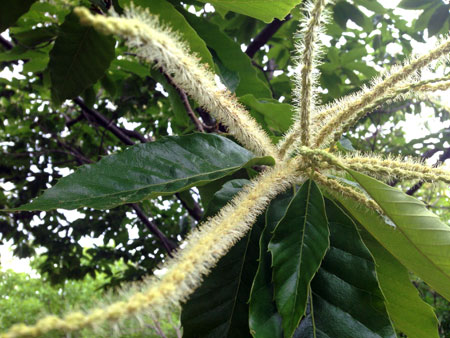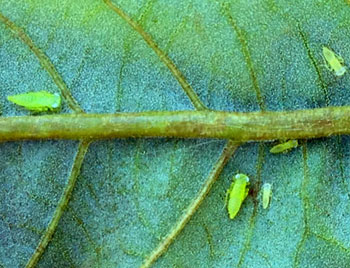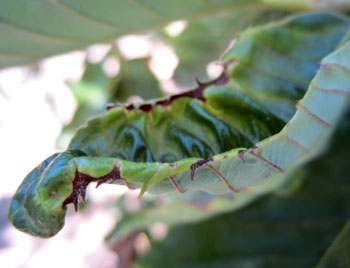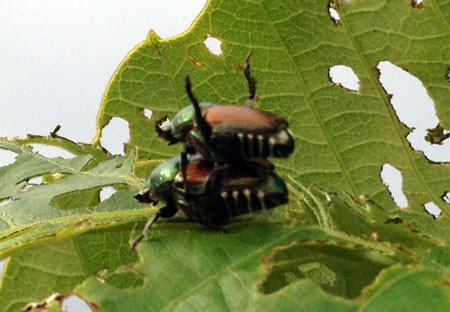Michigan chestnut update – July 12, 2013
Potato leafhopper numbers continue to expand in untreated Michigan chestnut orchards and pollen has filled the air in northwest Michigan orchards.
So far this season, the East Lansing Enviro-weather station has accumulated 1,192 GDD50 with 1.57 inches rain over the past week; the Clarksville Enviro-weather station has recorded 1,114 GDD50 and 0.32 inches of rain this past week; and the Northwest Michigan Horticultural Research Center accumulated 996 GDD50 with 0.57 inches of rain over the last week. Northwest Michigan chestnut orchards are shedding pollen.

Catkins shedding pollen on July 10, 2013.
Photo credit: Erin Lizotte, MSU Extension
All life stages of potato leafhoppers are being observed in significant numbers across the state. Like many plants, chestnuts are sensitive to the saliva of potato leafhopper, which is injected by the insect while feeding. Damage to leaf tissue can cause reduced photosynthesis which can impact production and quality, and damage the tree. Most injury occurs on new tissue on shoot terminals with potato leafhoppers feeding near the edges of the leaves using piercing-sucking mouthparts. Symptoms of feeding are becoming visible in orchards with high pressure. Heavily damaged leaves are cupped with necrotic and chlorotic edges and eventually fall from the tree. Severely infested shoots produce small, bunched leaves with reduced photosynthetic capacity.
Adult leafhoppers are pale to bright green and about 1/8 inch long. Adults are easily noticeable, jumping, flying or running when agitated. The nymphs (immature leafhoppers) are pale green and have no wings, but are very similar in form to the adults. Growers should also walk through their orchards, flipping over leaves and looking for adult potato leafhoppers and nymphs.
The most common classes of insecticides recommended for control of potato leafhoppers include the pyrethroids, carbamates, neonicotinoids and organophosphates. See the additional Michigan State University Extension article “Potato leafhopper management in chestnuts” for more information. Remember, even growers who believe they may have experienced crop losses due to the frost and freeze events this spring will still need to treat for potato leafhoppers to maintain tree health.


Left, Wingless potato leafhopper nymphs on the back of a chestnut leaf. Photo credit: Mario Mandujano, MSU.
Right, Symptoms of potato leafhopper feeding. Photo credit: Erin Lizotte, MSU Extension
Rose chafer adult activity has finally subsided for the season. Some growers experienced high levels of this generalist pest this season.
Unfortunately, just as rose chafer subsides, the first reports of Japanese beetle feeding and mating in orchards are beginning to trickle in. Japanese beetle adults are also considered a generalist pest and affect many crops found on or near grassy areas, particularly irrigated turf. Japanese beetle grubs feed on grass roots in early spring and again in the fall and can cause significant damage to turf. Larvae prefer moist soil conditions and do not survive prolonged periods of drought. Given the intense dry season Michigan experienced in 2012, we are not surprised to see lower Japanese beetle populations so far in 2013.
Adult Japanese beetles emerge in early July and feed on the top surface of leaves skeletonizing the tissue. If populations are high, they can remove all of the green leaf material from a plant. Japanese beetle adults measure 0.375 to 0.5 inches long with a green thorax and copper-colored wing covers. There are five tufts of white hairs on both sides of the abdomen and a pair of tufts on the end of the abdomen that can help distinguish them from other look-alike species.
Visual observation of adults or feeding damage is an effective scouting technique. Growers should scout along a transect through orchards at least weekly until detection, paying special attention to the tops of trees. Because of their aggregating behavior, they tend to be found in larger groups and are typically relatively easy to spot.

Japanese beetles mating. Chestnut leaves show typical feeding
damage. Photo credit: Mario Mandujano, MSU
There are no established treatment thresholds or data on how much Japanese beetle damage a healthy chestnut tree can sustain, but growers should consider that well-established and vigorous orchards will likely not require 100 percent protection. Carbamate (carbaryl) insecticides can provide immediate knockdown and seven days of residual activity against Japanese beetle adults. Organophosphates (Malathion and phosmet) can take longer to take effect (up to three 3 days), but provides 10 to 14 days of residual control.
Pyrethroids (bifenthrin, beta-cyfluthrin, cyfluthrin, gamma-cyhalothrin, lambdacyhalothrin, pyrethrins, zeta-cypermethrin, deltamethrin and fenpropathrin) have good knockdown activity and seven to 10 days of residual control, but can be a concern in orchards where mites are a problem. Pyrethroid use has been shown to flare mite populations as a result of its toxicity to beneficial predatory mites.
Neonicitonoids (imidacloprid, thiamethoxam, acetamiprid and clothianidin) act initially as a contact poison for two to five days, and then have a longer residual period of plant protection during which they have anti-feedant effects on adult beetles.
OMRI-approved organic options include neem-based products (azadirachtin) which have a one- to two-day residual and good knockdown activity as well as Surround (kaolin clay), which has had good results in blueberries and grapes and acts as a physical barrier and irritant. For more information on Japanese beetle management in chestnuts, refer to the article “Managing Japanese beetles in Chestnut for 2013.”
Beneficial predatory mites were also observed in orchards this week. As growers scout for mites, keep in mind that not all mites are created equal and be sure to determine if a mite is a pest mite, such as spider mites, or a beneficial mite before considering treatment. Predatory mites generally move much more quickly than pest mites and are an important ally in keeping pest populations low. Even a relatively small population of predatory mites is thought to significantly decrease the need for chemical control of pest mite species. So far this season there has been very limited numbers of pest mites (two-spotted spider mites and European red mite) reported on horticultural crops around the state.



 Print
Print Email
Email



